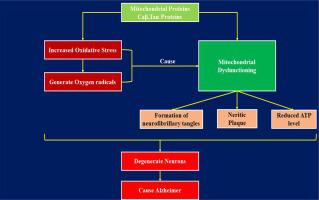当前位置:
X-MOL 学术
›
Mitochondrion
›
论文详情
Our official English website, www.x-mol.net, welcomes your
feedback! (Note: you will need to create a separate account there.)
Exploring the Role of Mitochondrial Proteins as Molecular Target in Alzheimer’s Disease
Mitochondrion ( IF 3.9 ) Pub Date : 2021-01-01 , DOI: 10.1016/j.mito.2020.11.008 Swati Chadha , Tapan Behl , Aayush Sehgal , Arun Kumar , Simona Bungau
Mitochondrion ( IF 3.9 ) Pub Date : 2021-01-01 , DOI: 10.1016/j.mito.2020.11.008 Swati Chadha , Tapan Behl , Aayush Sehgal , Arun Kumar , Simona Bungau

|
Brain is a fully differentiated organ and is sensitive towards oxidative damage of various compounds including lipids, proteins, and DNA that occurs during process of normal aging and is mainly due to its high energy metabolism and reduced activity of anti-oxidative defense mechanism. Mitochondria are dynamic ATP-generating organelles which constitutes cellular functions such as regulation of intracellular calcium, bio-energetic processes, and reduction-oxidation of cells. Such functioning is negatively affected due to the presence of amyloid β peptide (Aβ) which is involved in pathogenesis of Alzheimer disease (AD). Aβ interacts with mitochondria and leads to mitochondrial dysfunction. Mitochondrial dysfunction, abnormal interactions, oxidative stress, and mis-folding of synaptic proteins inside nervous system are explored and regarded as primary or initial features in insurgence of pathology (AD and other neurological disease). The major histopathological hallmarks of AD are characterized by presence of these hallmarks intracellularly, its further progression and exacerbation which leads to excessive accumulation of oligomeric as well as fibrillar-β-amyloid peptides (present extracellularly) and accumulation of neurofibrillary tangles intracellularly. The current review will focus on alterations and variation in mitochondria/mitochondrial DNA (mtDNA) and the rationale for involvement of related abnormalities in pathogenesis of AD.
中文翻译:

探索线粒体蛋白作为阿尔茨海默病分子靶点的作用
大脑是一个完全分化的器官,对正常衰老过程中发生的包括脂质、蛋白质和DNA在内的各种化合物的氧化损伤很敏感,主要是由于其高能量代谢和抗氧化防御机制的活性降低。线粒体是动态的 ATP 生成细胞器,构成细胞功能,如调节细胞内钙、生物能量过程和细胞的还原氧化。由于存在参与阿尔茨海默病 (AD) 发病机制的淀粉样蛋白 β 肽 (Aβ),这种功能会受到负面影响。Aβ 与线粒体相互作用并导致线粒体功能障碍。线粒体功能障碍、异常相互作用、氧化应激、神经系统内突触蛋白的错误折叠和错误折叠被视为病理学(AD和其他神经系统疾病)叛乱的主要或初始特征。AD 的主要组织病理学标志的特征在于这些标志在细胞内的存在,其进一步进展和恶化导致寡聚和纤维状-β-淀粉样肽(存在于细胞外)的过度积累和细胞内神经原纤维缠结的积累。本综述将重点关注线粒体/线粒体 DNA (mtDNA) 的改变和变异,以及 AD 发病机制中相关异常参与的基本原理。AD 的主要组织病理学标志的特征在于这些标志在细胞内的存在,其进一步进展和恶化导致寡聚和纤维状-β-淀粉样肽(存在于细胞外)的过度积累和细胞内神经原纤维缠结的积累。本综述将重点关注线粒体/线粒体 DNA (mtDNA) 的改变和变异,以及 AD 发病机制中相关异常参与的基本原理。AD 的主要组织病理学标志的特征在于这些标志在细胞内的存在,其进一步进展和恶化导致寡聚和纤维状-β-淀粉样肽(存在于细胞外)的过度积累和细胞内神经原纤维缠结的积累。本综述将重点关注线粒体/线粒体 DNA (mtDNA) 的改变和变异,以及 AD 发病机制中相关异常参与的基本原理。
更新日期:2021-01-01
中文翻译:

探索线粒体蛋白作为阿尔茨海默病分子靶点的作用
大脑是一个完全分化的器官,对正常衰老过程中发生的包括脂质、蛋白质和DNA在内的各种化合物的氧化损伤很敏感,主要是由于其高能量代谢和抗氧化防御机制的活性降低。线粒体是动态的 ATP 生成细胞器,构成细胞功能,如调节细胞内钙、生物能量过程和细胞的还原氧化。由于存在参与阿尔茨海默病 (AD) 发病机制的淀粉样蛋白 β 肽 (Aβ),这种功能会受到负面影响。Aβ 与线粒体相互作用并导致线粒体功能障碍。线粒体功能障碍、异常相互作用、氧化应激、神经系统内突触蛋白的错误折叠和错误折叠被视为病理学(AD和其他神经系统疾病)叛乱的主要或初始特征。AD 的主要组织病理学标志的特征在于这些标志在细胞内的存在,其进一步进展和恶化导致寡聚和纤维状-β-淀粉样肽(存在于细胞外)的过度积累和细胞内神经原纤维缠结的积累。本综述将重点关注线粒体/线粒体 DNA (mtDNA) 的改变和变异,以及 AD 发病机制中相关异常参与的基本原理。AD 的主要组织病理学标志的特征在于这些标志在细胞内的存在,其进一步进展和恶化导致寡聚和纤维状-β-淀粉样肽(存在于细胞外)的过度积累和细胞内神经原纤维缠结的积累。本综述将重点关注线粒体/线粒体 DNA (mtDNA) 的改变和变异,以及 AD 发病机制中相关异常参与的基本原理。AD 的主要组织病理学标志的特征在于这些标志在细胞内的存在,其进一步进展和恶化导致寡聚和纤维状-β-淀粉样肽(存在于细胞外)的过度积累和细胞内神经原纤维缠结的积累。本综述将重点关注线粒体/线粒体 DNA (mtDNA) 的改变和变异,以及 AD 发病机制中相关异常参与的基本原理。











































 京公网安备 11010802027423号
京公网安备 11010802027423号